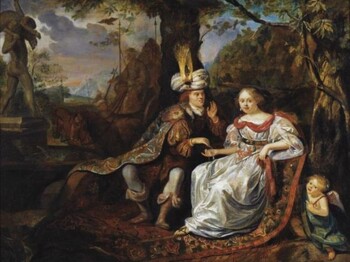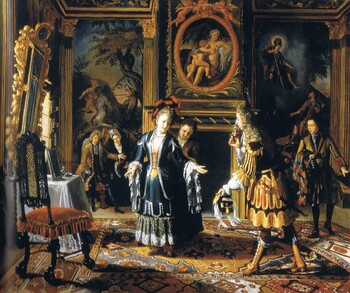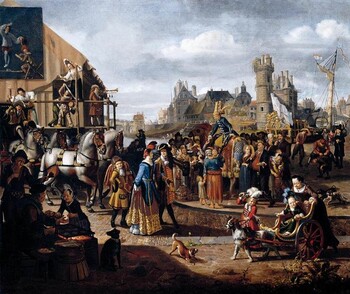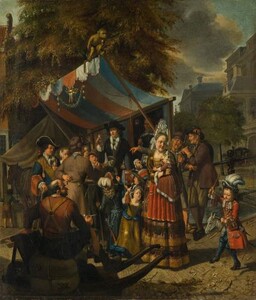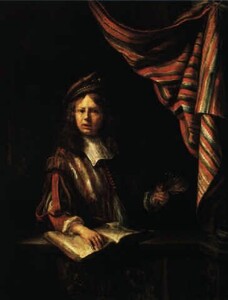11.500 €
The Temptation of Saint Anthony
Oil on canvas : 43,3 X 52,8 cm
Signed middle right “Naiveu”
Frame : 58,4 X 68,4 cm
In short
Matthijs Naiveu worked in his native Leiden and in Amsterdam in the last quarter of the 17th and the first quarter of the 18th century. He was a very versatile, original and innovative painter.
Here he has revitalized a traditional subject that goes back to Hieronymus Bosch. Saint Anthony lived in solitude an ascetic life of rigorous austerity and prayer, away from civilization. He had to fight temptation by the devil who came to him under the most seductive or bizarre forms.
About Matthijs Naiveu
Dutch painter
Leiden 1647 - 1726 Amsterdam
His name is sometimes spelt Neveu.
He was the son of a wine merchant and inn-keeper from Rotterdam. His grandfather had been a skipper on the River Meuse in Liège.
Naiveu was a very versatile painter: he painted genre scenes, galant companies, festivities and performances, he occasionally also painted portraits, biblical scenes and still lifes.
He began his training with Abraham Toorenvliet (c. 1620-92), a glass painter and drawing master in Leiden, father of Jacob Toorenvliet.
From 1667 to 1669 Naiveu was apprenticed to the Leiden 'Fine' painter Gerrit Dou, who received 100 guilders a year (an exceptionally high sum) for his instruction from a Leiden notary who, following Naiveu’s parents’ death, was the custodian of Matthijs and of the three other children.
In 1671 Naiveu entered the Leiden Guild of St Luke, of which he became one of the Heads in 1677 and again in 1678.
He married in 1575 a widow with a 3-year old daughter; the couple got three more children.
In 1678/79, aged 32, he moved to Amsterdam, probably because he wanted to make an ambitious professional advancement as a portrait painter; recently Amsterdam had lost a number of established portrait painters.
Later Naiveu was appointed hop inspector. This work did not prevent him of producing a considerable number of paintings.
The earliest known work by Naiveu is dated 1668, the latest 1721.
There are dated paintings for almost every year in between; his most productive periods were 1675-79 and 1705-12, his most productive year was 1677, that is the year before his move to Amsterdam.
About the Temptation of Saint Anthony
Saint Anthony was born circa 251 in Egypt. We know his life fairly well, thanks to the biography written by his disciple Athanasius.
Following his parents’ death he gave away his money and around the age of 20 he started a life full of want as a hermit becoming the most famous monk of ancient Christendom. He lived an ascetic life of austerity, sacrifice and extreme solitude.
The first 35 years he lived retired into solitude in a grotto next to his birthplace, the following 20 years on a mountain on the other bank of the Nile and finally in a community of hermits in an oasis in the desert.
Though he led a hard life, full of deprivation, Anthony was very long-lived: death (which he had predicted) took him at the age of 105, on the 17th of January 355 (or 356).
Saint Anthony became a model for the denial of vice, specifically pleasures of the flesh. During his isolation he had to fight temptation by the devil under different forms, especially under that of the most seductive woman or also of wild beasts. He had to fight evil thoughts, hallucinations, lusts and desires of all kind.
Anthony’s veneration grew rapidly in the Western church:
- in the 11th century a Byzantine emperor had given his relics to a French count;
- accounts of miraculous healing of skin diseases, especially those afflicted with the widely spread St. Anthony’s fire, an inflammation of the skin due to ergot poisoning, led to the founding of the Hospital Brothers of Saint Anthony;
- his life was also described in the popular ‘Legenda Aurea’ or Golden Legend. This was a medieval collection of legendary lives and accounts of miracles of important Christian saints compiled around 1260 by Jacobus de Voragine, the archbishop of Genoa.
The iconographical theme of the temptation of Saint Anthony goes back to the late Middle Ages, to Hieronymus Bosch. It was a very popular theme in Holland and in Flanders, where we can trace a line from Pieter Brueghel I into the 17th century to David Teniers II, David Ryckaert III and Mattheus van Helmont.
About our painting
Saint Anthony tries to withstand an old bawd who is presenting him a beautiful young woman. In the left foreground parades a strange, winged dragon while in front of a gate a small devil tries to seduce our saint with his flute music. The thistle in the right foreground testifies of the interest around 1700 in forest floors and nature pieces.
Why should you buy this painting?
Because this great, extravagant composition was painted by one of the most interesting, daring and innovative Dutch painters at the end of the Baroque period.
Comparative paintings
Click photos for more details

